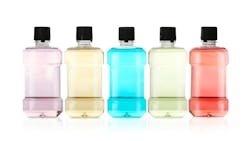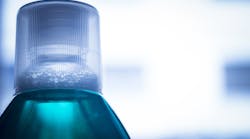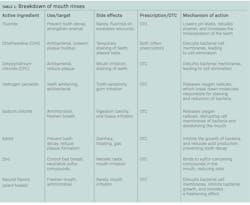The active ingredients behind oral rinses
Listen to the article on our podcast!
In daily interactions with patients, discussions about mouth rinses are commonplace—whether focusing on preventing caries or aiding in gingival and periodontal health. For dental hygienists, the challenge lies in navigating the myriad of options available on the market to select the most suitable mouthwash for an individual’s oral health needs.
This article aims to provide dental professionals with a comprehensive guide to choosing the optimal mouthwash by examining the efficacy of various active ingredients and considering factors such as dry mouth that may influence selection. The purpose of mouth rinses is to delay biofilm growth in the oral cavity, especially on the teeth and surrounding periodontal tissues. By understanding the role of active ingredients in mouth rinses and their implications on oral health, dental professionals can make informed decisions to enhance patient care and satisfaction.
Mouth rinse categories
The American Dental Association (ADA) has systematically classified oral rinses into two primary subcategories—cosmetic and therapeutic—due to their varying active ingredients and properties.1 These distinctions guide dental professionals and consumers in understanding the intended use and benefits of various mouth rinse formulations.
Therapeutic mouth rinses are available over the counter (OTC) and by prescription. These mouth rinses provide patients with antimicrobial agents to kill bacteria associated with gingivitis, periodontal disease, and dental decay.
Cosmetic mouth rinses are also available OTC and include ingredients that offer temporary benefits. The primary function of cosmetic mouth rinses is to provide temporary relief, such as leaving patients with fresh breath or relieving dry mouth after use. While effective, cosmetic mouth rinses contain active therapeutic ingredients but often don’t remove harmful bacteria needed to maintain a healthy oral biome.
Composition of mouth rinses
Table 1 gives a breakdown of ingredients, uses, side effects, and mechanism of action in mouth rinses.
Water or alcohol solvents: The typical composition of therapeutic and cosmetic mouth rinses consists of antimicrobial properties, with water or alcohol acting as solvents. Alcohol solvents, such as ethyl alcohol and glycerin, are the most commonly used active ingredients in both therapeutic and cosmetic mouth rinses found on the market today.2 Mouth rinse products contain ingredients with a nonalcohol solvent option for patients who may have contraindications to the alcohol component of certain mouth rinses.
Other active ingredients: These ingredients include sweeteners, preservatives, coloring or cooling agents, surface-acting and thickening agents, and added flavoring (plant-based).2-4 Active ingredients most commonly listed in mouth rinses include—but are not limited to—fluoride, chlorhexidine (CHX), cetylpyridinium chloride (CPC), hydrogen peroxide, sodium chlorite, xylitol, and natural flavors such as menthol, mint, green tea, and eucalyptus.2-4
Fluoride: Fluoride is the first and most common active ingredient in most therapeutic and cosmetic mouthwashes. Fluoride is one of the most effective ingredients in mouth rinses due to its ability to lower pH levels, rebuild enamel, and increase the mineralization of the teeth.4,5 The clinical effectiveness is due to its chemical solubility in the oral cavity with each use. Fluoride’s primary function is to lower pH in the oral cavity and chemically assist in stabilizing and binding the fluoride to the teeth, increasing efficacy against tooth decay.5 The most common fluoride ion in mouth rinses is sodium fluoride, which is safe for patients ages 6 and older.⁶ Ingestion of fluoride or overuse of the mineral can have adverse effects such as upset stomach, fluorosis, nausea, or vomiting.6
CHX and CPC: These are other active ingredients found in mouth rinses and contain antimicrobial properties that aid in reducing harmful bacteria in the oral cavity. Due to its broad-spectrum ability to disrupt biofilm growth, the antiseptic and antiviral components of CHX and CPC reduce gingival inflammation, bleeding, and redness.3,4,7 CPC in mouth rinses has been identified as the most effective antiviral ingredient for reducing viruses such as influenza, herpes simplex type 1, and SARS-CoV-2 (novel coronavirus responsible for causing the respiratory illness known as COVID-19).8 CPC is a tasteless solvent with relatively no side effects.2,8
The combined action of the antibacterial and antiviral ingredients is comparable to fluoride in therapeutic mouth rinses. Collectively, they reduce bacteria, fungi, and the transmission of viruses as well as increase periodontal health. Adverse side effects of CHX include xerostomia, tongue discoloration, teeth staining, altered taste, and burning sensation.7 Other formulas of CHX mouth rinses have been developed to reduce staining and discoloration of the tongue and teeth while maintaining efficacy. Dental professionals who recommend a therapeutic mouth rinse containing CHX should follow manufacturer guidelines to ensure minimal adverse effects and increase patient satisfaction.
Hydrogen peroxide: Hydrogen peroxide is another active ingredient in mouth rinses, which can help whiten teeth and reduce oral bacteria.2 Products containing hydrogen peroxide help reduce teeth staining through oxidation. The process of oxidation produces free radicals, which assist with breaking down larger and darker-colored molecules of stain. The oxidation process can penetrate several layers of stain depending on the concentration within the mouth rinse. Results vary with use and the patient’s current oral health conditions. Another factor to consider is that higher concentrations of hydrogen peroxide can cause side effects such as damage to the enamel and surrounding tissues, leading to sensitivity.
Sodium chlorite: Sodium chlorite, found in some therapeutic formulations of mouth rinses, acts primarily as an antimicrobial agent. When properly diluted, sodium chlorite can help reduce bacteria and other microorganisms in the mouth. It is important to note that sodium chlorite is a strong oxidizing agent and should be used cautiously and in accordance with the manufacturer’s instructions. In its concentrated form, sodium chlorite is toxic and may cause irritation or damage to oral tissues if not properly diluted. When properly diluted, sodium chlorite is typically present in safe and effective concentrations in mouth rinses, providing antimicrobial benefits without significant adverse effects.9 Sodium chlorite’s mechanism of action works by releasing oxygen ions, which disrupt the cellular structure of bacteria, leading to obliteration.
Xylitol: Sweeteners and natural flavors are incorporated into mouth rinses to enhance taste and promote patient adherence. Xylitol, a commonly featured active ingredient in therapeutic and cosmetic mouth rinses, serves as a potent antimicrobial agent by inhibiting biofilm formation. While contributing to the product’s flavor profile, xylitol primarily functions to bolster anticavity efficacy. Its principal attribute lies in disrupting the energy metabolism of Streptococcus mutans—the bacteria responsible for dental caries—resulting in cell death upon application.10 Derived from plants, xylitol (a sugar alcohol) aids in preventing demineralization and alleviating dry mouth, rendering it particularly advantageous for patients with gingival and dental sensitivity.
Natural flavors: Likewise, natural flavors such as menthol, eucalyptus, and mint are deemed active components, imparting flavor to mouth rinses while naturally possessing antimicrobial properties. Phytochemicals extracted from these plant-based flavors serve as cooling agents or fragrances.2 Moreover, herbs and plant extracts exhibit resistance against various pathogens, offering safe and effective alternatives to traditional active ingredients.
Ensuring personalized oral hygiene
A comprehensive understanding of the active ingredients found in therapeutic and cosmetic mouth rinses, along with their respective mechanisms of action, empowers dental professionals to make informed decisions regarding product selection tailored to meet the oral health requirements of every patient. By discerning the efficacy and modes of action of these ingredients, practitioners can optimize patient care and satisfaction, ensuring the provision of personalized and effective oral hygiene regimens. This informed approach not only enhances treatment outcomes but also fosters greater patient confidence and compliance in maintaining optimal oral health.
Editor's note: This article appeared in the June 2024 print edition of RDH magazine. Dental hygienists are eligible for a complimentary print subscription. Sign up here.
References
- Mouthrinse (mouthwash). American Dental Association. Updated December 1, 2021. https://www.ada.org/resources/ada-library/oral-health-topics/mouthrinse-mouthwash/
- Radzki D, Wilhelm-Węglarz M, Pruska K, Kusiak A, Ordyniec-Kwaśnica I. A fresh look at mouthwashes – what is inside and what is it for? Int J Environ Res Public Health. 2022;19(7):3926.
doi:10.3390/ijerph19073926 - Rajendiran M, Trivedi HM, Chen D, Gajendrareddy P, Chen L. Recent development of active ingredients in mouthwashes and toothpastes for periodontal diseases. Molecules. 2021;26(7):2001. doi:10.3390/molecules26072001
- Yazicioglu O, Ucuncu MK, Guven K. Ingredients in commercially available mouthwashes. Int Dent J. 2024;74(2):223-241.
doi:10.1016/j.identj.2023.08.004 - van Swaaij BWM, Slot DE, Van der Weijden GA, Timmerman MF, Ruben J. Fluoride, pH value, and titratable acidity of commercially available mouthwashes. Int Dent J. 2024;74(2):260-267.
doi:10.1016/j.identj.2023.09.002 - Lubojanski A, Piesiak-Panczyszyn D, Zakrzewski W, et al. The safety of fluoride compounds and their effect on the human body – a narrative review. Materials (Basel). 2023;16(3):1242.
doi:10.3390/ma16031242 - Brookes ZLS, Bescos R, Belfield LA, Ali K, Roberts A. Current uses of chlorhexidine for management of oral disease: a narrative review. J Dent. 2020;103:103497. doi:10.1016/j.jdent.2020.103497
- Riveira-Muñoz E, Garcia-Vidal E, Bañó-Polo M, et al. Cetylpyridinium chloride-containing mouthwashes show virucidal activity against herpes simplex virus type 1. Viruses. 2023;15(7):1433. doi:10.3390/v15071433
- Mekonnen S. Chlorine dioxide and sodium chlorite oral rinse. Poison Control National Capital Poison Center. https://www.poison.org/articles/oral-rinse-product-safety-214
- Janakiram C, Kumar CVD, Joseph J. Xylitol in preventing dental caries: a systematic review and meta-analyses. J Nat Sci Biol Med. 2017;8(1):16-21. doi:10.4103/0976-9668.198344
About the Author

Samantha Farrar, DHSc, MPH, BSDH, RDH
Samantha Farrar, DHS, MPH, BSDH, RDH, has a doctoral degree, excelling as a clinician, educator, and board examiner. With a special passion for pediatric dentistry and research, she brings 18 years of experience to her practices. She is an adjunct faculty member at the College of DuPage in Glen Ellyn, Illinois, and is dedicated to shaping the next generation of dental professionals. Driven by a commitment to oral health advancement, she continuously strives to improve dental care for patients of all ages.

Stacy Castronova, DHS, MSDH, BSDH, RDH
Stacy Castronova, DHS, MSDH, BSDH, RDH, adjunct faculty at the College of DuPage in Glen Ellyn, Illinois, has over 20 years of experience in the profession. With advanced degrees in dental hygiene, science education, and health science, focusing on educational leadership, she is a presenter and author of peer-reviewed articles. She has presented research at the National American Dental Hygienists’ Association and the Association of Schools Advancing Health Professions and is actively involved in the Illinois Dental Hygienists’ Association.



